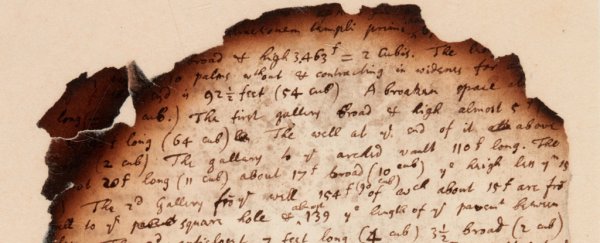Sir Isaac Newton, the acclaimed physicist, mathematician, and astronomer, may be one of the most renowned scientists of all time, but his wide-ranging research took him to strange places far outside what we now consider to be science.
Amidst his outstanding legacy of academic output, numerous fragments and unpublished notes – many discovered after his death in 1727 – stand as a testament to his long and said-to-be obsessive interest in matters of the occult, alchemy, and biblical apocalypse theory.
These mystical leanings – much of which would have been considered heretical thinking in Newton's day – are evidenced in some fragmentary manuscript notes currently being auctioned by Sotheby's.
In this case, the texts are literally fragments, in that they are the scorched survivors of a fire, said to have been started by an upset candle accidentally toppled by Newton's dog, Diamond.
 (Isaac Newton/Sotheby's)
(Isaac Newton/Sotheby's)
Whether that purported chain of events is entirely true isn't clear, but what is clear is that the flame-licked sheets form part of Newton's lesser-known canon, dealing with obscure theories we would now firmly categorise as pseudoscience.
In the pages – which at time of writing have a leading bid of £280,000 (about US$375,000) – Newton muses on ancient Egypt's Great Pyramid of Giza, which Newton believed was designed around an Egyptian unit of measurement called the royal cubit.
Newton thought that by quantifying the royal cubit, he might be able to refine his own theories on gravitation, and in so doing provide an unprecedentedly accurate measure of the circumference of the Earth – while also unlocking other obscure and 'sacred' geometrical insights, that might ultimately predict when the world would end, as foretold in the Bible.
"He was trying to find proof for his theory of gravitation, but in addition the ancient Egyptians were thought to have held the secrets of alchemy that have since been lost," Gabriel Heaton, Sotheby's manuscript specialist, told The Observer.
"Today, these seem disparate areas of study – but they didn't seem that way to Newton in the 17th century."
Newton wasn't the first to have these sorts of ideas, and he was also not the last. While such pyramidology has now drifted outside the bounds of serious science – depending on where you look on the internet, at least – once upon a time, it consumed the attention of one of the greatest minds on the planet.
"These notes are part of Newton's astonishingly complex web of interlinking studies – natural philosophy, alchemy, theology – only parts of which he ever believed were appropriate for publication," the auction listing explains.
"It is not surprising that he did not publish on alchemy, since secrecy was a widely-held tenet of alchemical research, and Newton's theological beliefs, if made public, would have cost him (at least) his career."
